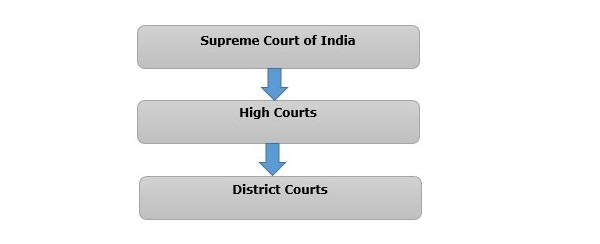The Supreme Court of India acts as the highest court of appeal in civil and criminal cases. It hears appeals against the decisions of the High Courts. However, the Supreme Court hears any case if it pleases to do so.
The Supreme Court has got jurisdiction to take up any dispute such as −
Between citizens of the country;
Between citizens and government;
Between two or more state governments; and
Between governments at the union and state level.
The Supreme Court and the High Courts are the custodian of our constitution. They have the power to interpret the Constitution of the country.
The Supreme Court can declare any law of the legislature or the actions of the executive unconstitutional if such a law or action is against the provisions of the Constitution.
The Supreme Court has ‘Original Jurisdiction’. It means – some cases can be directly considered by the Supreme Court without going to the lower courts.
The Supreme Court has ‘Writ Jurisdiction’. It means - any individual, whose fundamental right has been violated, can directly go to the Supreme Court for appropriate remedy.
The Supreme Court is the highest court of appeal (Appellate Jurisdiction). It means - a person can appeal to the Supreme Court against the decisions of the High Court.
The Supreme Court has ‘Advisory Jurisdiction’. It means - the President of India can refer any matter that is of public importance or involves interpretation of Constitution to Supreme Court for advice.
Article of 137 of the Constitution states that the Supreme Court shall have the power to review any judgment pronounced or order made by it.
Article 144 of the Constitution states that all authorities, civil and judicial, in the territory of India shall act in aid of the Supreme Court.
The chief instrument through which judicial activism has come into existence in India is Public Interest Litigation (PIL) or Social Action Litigation (SAL).
When a case is filed not by aggrieved people, but rather on their behalf, someone else, as it involves a consideration of an issue of public interest, hence, it is known as Public Interest Litigation (PIL) or Social Action Litigation (SAL).
The two most important rights of Judiciary are −
It can restore fundamental rights by issuing writs of Habeas Corpus; mandamus etc. under Article 32 of the Constitution and the same action can be taken by the High Courts as well under the Article 226 of Constitution.
Under Article 13 of the Constitution - the Supreme Court can declare the concerned law as unconstitutional and therefore non-operational.
The Judicial Review (JR) is one of the most important powers of the Supreme Court.
Judicial Review means the power of the Supreme Court to examine the constitutionality of any law; so, if the Court arrives at the conclusion that the aforesaid law is inconsistent with the provisions of the Constitution, such a law is declared as unconstitutional and inapplicable.
The Supreme Court (and the High Courts) has the power to check the Constitutional validity of any legislation or action of the executive, when it is challenged before them. This power is called judicial review.
The Supreme Court of India also guards the Constitution against any change in its basic principles by the Parliament.
The independence and powers exercised by the Indian judiciary in India make the Supreme Court to act as the guardian of the Fundamental Rights.
The Indian Constitution is based on a subtle principle of limited separation of powers and checks and balances, which means - each organ of the government has a clear area of functioning. For example,
The Parliament is supreme in making laws and amending the Constitution;
The Executive is supreme in implementing the laws; and
The judiciary is supreme in settling disputes and deciding whether the laws that have been made are in accordance with the provisions of the Constitution.
In a landmark judgment of Kesavananda Bharati case (1973), the Supreme Court ruled that there is a ‘Basic Structure’ of the Constitution and nobody — not even the Parliament (through amendment)— can violate the basic structure.
In Kesavananda Bharati case, the Supreme Court did two things −
It said that right to property was not part of the basic structure and therefore could be suitably amended.
The Court reserved to itself the right to decide whether various matters are part of the basic structure of the Constitution.



No comments:
Post a Comment